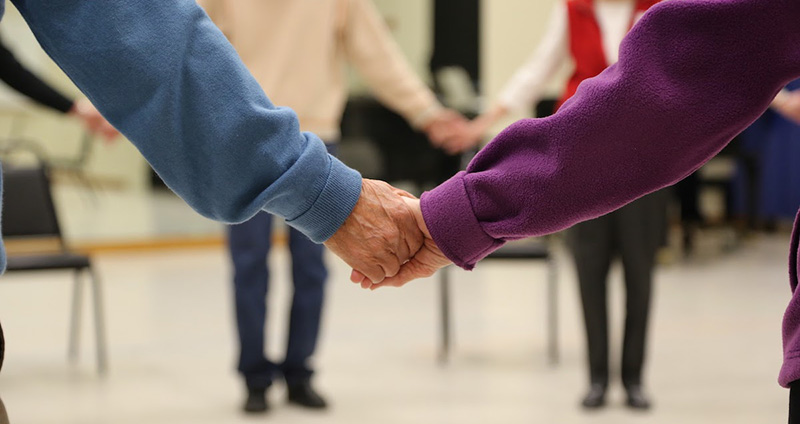Despite quarantine restrictions, the continuation of this long-running Krannert Center class throughout the pandemic has helped those with Parkinson’s disease and other disabilities maintain both their personal health and a strong sense of community.
When Illinois Dance professor Laura Chiaramonte first took over leadership of the program in 2014 after the passing of former director Kate Kuper, Dance for People with Parkinson’s (Dance for PD) had already expanded to include locations all around the world. However, University of Illinois was the first university to find its footing with the project.
“The Krannert Center has been offering this class for well over 10 years now,” Chiaramonte explains. “It’s been a huge success, and the participants find a lot of comfort and joy [in] the classes.”
Co-leader and owner/director of Urbana Dance Company Kate Insolia joined two years ago and has been in love with it ever since.
“We’re here to uplift people and join together, and have joy for our bodies, joy for movement, joy for dancing, joy for life, joy in being together,” Insolia says. This joy and robust social environment, as well as myriad research-backed physical and health benefits for the participants, are the key elements that have given the work of Dance with PD such a distinguished reputation ever since it was launched in 2001.
As the first campus to take on Dance with PD, the Krannert Center’s program has unique attributes that fit with the needs of local community members. Chiaramonte and Insolia work closely with the Mark Morris Dance Group, the company that originated Dance for PD. The group actually visits campus annually via a residency with the Krannert Center (in non-pandemic times). Equally impressive is the accessibility of the class; participation is completely free of charge. Chiaramonte credits this advantage to the Krannert Center; “Because the Krannert Center of Performing Arts is a nonprofit organization, a lot of the donors participate and donate to the class as well to help be able to provide these free classes and workshops to the community.”
So how does the word get out? How do older community members find out about a class that takes place on a university campus?
Again, Chiaramonte and Insolia point to the Krannert Center as the source of commercial success. The wide variety of people who end attending classes enriches the experience as a whole for both participants and instructors alike. Insolia notes that “Most of the people who participate do have Parkinson’s, unless their partner is with them… but we also do encourage that anyone can come to the class.” Even university students who are studying in fields such as kinesiology and neuroscience will occasionally participate or observe, “which is nice because you can talk with them and hear how they perceive the class, and then you can build more knowledge in your repertoire.”
However, there are definitely challenges sprinkled throughout the positivity generated by Dance with PD and its participants. “People sometimes feel shy about dancing,” Insolia admits with a smile. She describes how the class progresses to build a sense of comfort, beginning with gentle stretching and culminating in a choreographed piece. The class is inclusive of all physical abilities and encourages participants to dance in whatever way is most beneficial for them.
“I think that the joy component is so critically important,” Chiaramonte adds. “Once [there’s] that joy of dancing and being around the other people having a good time…. there’s a lot of laughter, and they can see that they’re not alone. And so when they can feel that then they start to have more confidence.” Participants are then able to more fully engage with the movement, the music, and each other.
“When they start to hear that rhythm, their body responds to that rhythm,” Chiaramonte explains. She describes this response as a gateway for participants with Parkinson’s to create a new “link” between their bodies and minds, allowing them to move more easily. Having a live piano accompanist, Beverly Hillmer, adds an extra boost to this process as well.
Moving the program into a Zoom format has unfortunately made some of this bodily and emotional engagement more difficult to achieve. But while technology and lack of physical interaction do create barriers, Chiaramonte and Insolia have largely good things to say about the new meeting structure.
“We have the same folks that come every month, and we can’t wait to see each other,” says Insolia. “They’re still finding enjoyment out of it because… that community and togetherness is really important, especially during a time of isolation.”
But participants aren’t the only ones finding joy in the class. Chiaramonte describes it as “the highlight of my month.” Insolia does as well. “I love getting to see the participants every month and build that relationship,” she says. “It teaches you compassion… It’s about just getting to be with people, and enjoy life, and music, and dance, and community.”
Dance for PD at Illinois continues to be held monthly over Zoom with the next class planned for April 9th. And given its years-long record of success, it seems likely to continue flourishing for many more.








